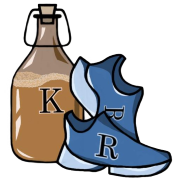
Back in 2004, after running my first half marathon on a whim and surprising myself with how well it went, I decided I wanted to see what I could really do with a structured training plan. That summer, I signed up for the Crystal Lake Half Marathon and got serious about training. I had 14-mile long runs on my schedule and was committed to hitting them. Little did I know that running with back pain was about to change my plans.
Around that same time, some friends were moving, and I offered to help. Lots of lifting, twisting, and hauling heavy furniture—things my back probably wasn’t thrilled about. I had dealt with occasional back issues since high school, and sure enough, I tweaked something. It felt a little off, but nothing major. I kept following my training plan, and once I started running, the discomfort usually faded. No big deal… or so I thought.
A week later, while visiting my grandmother with my wife and two young kids, I was helping my newly potty-trained daughter in the bathroom. As I bent to lift her up, I never even got her off the ground—because I went down instead. Hard. It felt like an electric shock ripping through my lower back near my tailbone. I ended up on my hands and knees, unable to move, barely able to crawl back to the other room where my wife and grandmother were sitting. Their shocked expressions told me all I needed to know: I was in trouble.
Fortunately, my uncle arrived, and with the help of my wife, they got me into a wheelchair—the youngest person, I’m sure, to ever be wheeled out of a retirement home. The car ride home was brutal. Every little bump in the road sent fresh waves of pain through my back. By Monday, I saw a doctor, who diagnosed me with muscle spasms and sent me home with muscle relaxants and painkillers. But honestly, they didn’t do much. The only real cure was rest, and that meant my second half marathon wasn’t happening.
I was disappointed, of course, but I took away some key lessons. The doctor gave me exercises to strengthen my core and stabilize my back—things like bird dogs and piriformis stretches. And for years, I kept up with strength training enough to keep major back issues at bay.
20 Years Later, History Repeats Itself
Fast forward to 2024. I was in the best running shape I’d been in for years. After a strong half marathon in August, I was gearing up for a December marathon, ready to push my limits again. Then, one seemingly small moment changed everything—just like it had two decades earlier.
My mom called. Her car battery had died, and she needed help getting it to the auto parts store for a replacement. I didn’t think twice. Batteries are heavy, but I managed to wrestle the old one out and haul it into the trunk. At the store, the new battery had two handles, forcing me to carry it awkwardly in front of me. As I bent forward to set it into my trunk—there it was. A familiar, ominous sensation on my left side.
I went home and told my wife, ‘Remember what happened in 2004? I think I just did it again.’
At first, it wasn’t too bad. I even left for a work trip to Sweden, where my wife joined me so we could visit friends. Stockholm is one of my favorite places to run, and despite the nagging feeling in my back, I didn’t want to miss out. I convinced myself it was fine, and after the first mile, the discomfort would fade—just like before.
That week, I pushed my luck. I ran a 12-mile loop around a lake, followed by a 7-mile city walk with my wife. By the time we got on the plane home, my back was probably hanging by a thread. Then, I got COVID.
COVID itself wasn’t the issue—I’ve had it a couple of times, and for me, it’s usually just a minor annoyance. But on that Tuesday afternoon, while still feeling a little woozy from being sick, I got up too fast from a nap, lost my balance, and instinctively planted all my weight on my left leg. That was it. Just like 20 years earlier, I crumpled to the floor, and my back made it clear: I had ignored it for too long.
The Cost of Not Listening
This time, the aftermath was worse. I could barely sleep for a month. Lying down was excruciating, so I spent nights trying to sleep upright. My training completely stopped. I debated whether I’d even attempt the marathon, eventually downgrading to the half. Three months after the injury, I toed the starting line in December—running my slowest half marathon ever. My first six miles went okay, but my hips tightened up badly from lack of training. I had to walk, stretch, and shuffle my way to the finish, a full 30 minutes slower than my August race.
Lesson (Finally) Learned
So here’s the lesson that took me 20 years to fully understand: Back injuries are serious and running with back pain is not a good idea. Rest is essential. Strength work matters. And sometimes, missing a few runs is better than losing months of training—or an entire race season.
If you’ve got a nagging injury, don’t ignore it. Address it early. Strengthen what’s weak. And if your back is telling you to stop, listen. I learned this lesson the hard way—twice. Hopefully, you won’t have to.
Until next time, keep running (but train smart).

Leave a Reply
You must be logged in to post a comment.